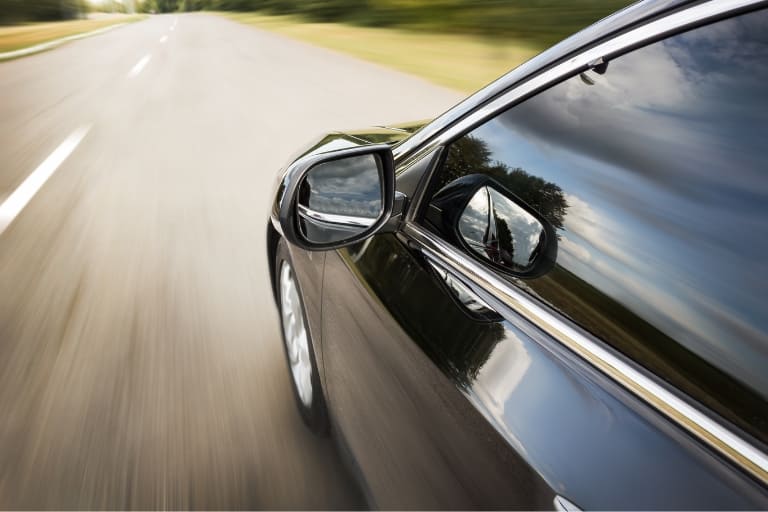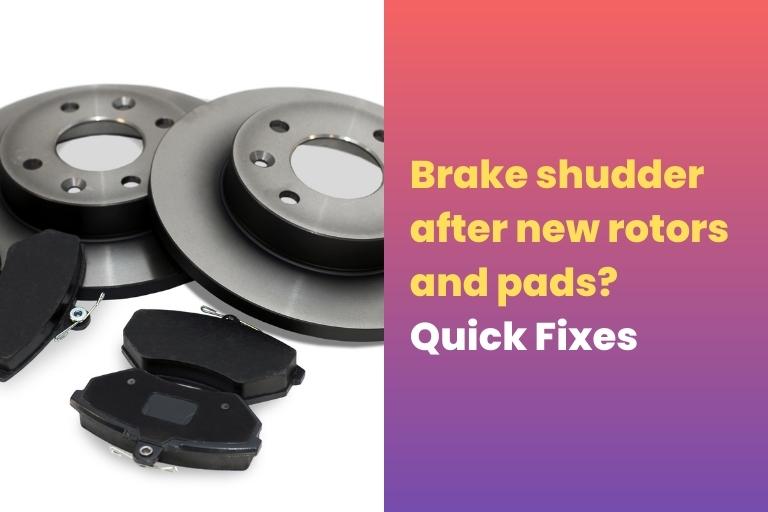Have you recently upgraded your ride with shiny new brake rotors and pads, only to be met with an unexpected and annoying brake Shudder? We understand your annoyance! Nothing is more frustrating than putting time and money into enhancing your vehicle’s braking performance only to discover a new problem. But don’t worry!
In this article, we’ll look at the usual occurrence of brake shudder after replacing rotors and pads. We’ll look at the various causes, how to identify the problem, and practical solutions for getting your brakes back to smooth, dependable stopping power. So strap in, and let’s solve the enigma of brake tremor after a brake upgrade!
You May Also Like: Does the Emergency Brake Lock All Wheels?
Contents
Why does the brake shudder after new rotors and pads?

You’ve recently replaced your brake rotors and pads, anticipating smoother and more responsive braking. However, you detect an irritating brake tremor, which makes you doubt your recent brake improvement. So, what may be the source of this problem?
Uneven rotor thickness is one probable cause of brake tremors after replacing rotors and pads. New rotors must be correctly mated with the pads for the best braking effectiveness when installed. However, thickness differences may occur if the rotors are not machined or changed equally. This can cause unequal braking power to be applied to the pads, causing the brake pedal to pulse or vibrate and, eventually, brake shudder.
Another potential cause of brake shudder is pad deposits. Brake pads are constructed of friction material that wears down with usage. When new pads are installed, they must “bed in” or create a good contact pattern with the rotors. If the bedding-in procedure is not followed correctly or the pads are poor quality, deposits can form on the rotor surface. These deposits might cause an uneven surface, resulting in a brake shudder when braking.
Inadequately torqued wheel lug nuts might also lead to brake shudder. If the lug nuts are not torqued to the manufacturer’s requirements, unequal pressure will be exerted on the rotor, producing warping and braking Shudder.
How does Break Shudder to happen?
Various factors, including unequal rotor thickness, pad deposits, and incorrect lug nut torquing, can cause brake shudder. Unequal rotor thickness can cause an unequal application of braking force to the pads, resulting in an uneven contact surface and brake shudder. Pad deposits on the rotor might cause an uneven surface, resulting in a brake shudder when the brakes are engaged. Inadequate lug nut torquing might result in unequal pressure on the rotor, causing warping and brake shudder.
Different scenarios When Shudder can happen
Here’s an explanation of the several conditions that might cause brake shudder:
Car Shudder When I Brake?
It might be due to uneven rotor thickness or pad deposits if your automobile shudders or vibrates when you apply the brakes. As previously stated, unequal rotor thickness can result in uneven braking power applied to the pads, resulting in an uneven contact surface and brake shudder. Similarly, suppose the brake pads must be correctly bedded in or are low-quality. In that case, they can leave deposits on the rotor surface, creating an uneven surface and generating a braking Shudder when applied.
Brakes Shudder When Stopping
When you come to a stop and feel your brakes shuddering or vibrating, it could be due to warped rotors. Brake rotors can warp over time due to heat build-up, heavy braking, or other factors. Warped rotors can cause an uneven contact surface with the brake pads, resulting in a brake shudder during stopping. This can also happen if the rotors are not properly installed or torqued, leading to uneven pressure on the rotor surface and brake shudder.
Brake Shudder at High Speed

There might be a lot of causes for brake shudder at high speeds. Uneven rotor thickness is a typical reason, which can result in an uneven contact surface with the brake pads, resulting in brake shuddering at high speeds. Another probable reason is the accumulation of brake pad material on the rotor surface, which is referred to as “glazing.” Glazing might result in an uneven surface, and brake shudder at high speeds. Furthermore, problems with suspension components or wheel balance might lead to brake shuddering at high speeds.
In all of these cases, it’s critical to have your brakes inspected and evaluated by a trained mechanic to pinpoint the specific reason for the brake shudder and repair it correctly for safe and smooth braking performance.
How to Fix Brake Shudder?
Here’s an illustrated guide on repairing brake shudder, including safety measures to take:
Precautions and safety measures:
- Always park your car on a level and sturdy surface.
- Wear the proper personal protective equipment (PPE), such as gloves and eye protection.
- Follow the directions and requirements provided by the manufacturer for your car’s make and model.
- If you are unsure or inexperienced with brake repairs, it is best to seek the advice of a competent technician.
Step 1: Take out the Caliper
- Loosen the lug nuts on the afflicted brake’s wheel.
- Lift the car using a jack and secure it with jack stands.
- To obtain access to the braking assembly, remove the wheel.
- Remove the bolts that hold the caliper to the bracket with a socket or wrench.
- To avoid stressing the brake line, carefully hang the caliper with a wire or bungee cord.
Step 2: Remove and inspect the brake pads
- Take the brake pads out of the caliper bracket.
- Examine the brake pads for signs of wear, unevenness, or damage.
- Replace the brake pads if they are worn unevenly or damaged.
Step 3: Remove and inspect the brake rotors
- Remove the bolts that hold the brake rotor to the hub with a socket or wrench.
- Remove the brake rotor from the hub with care.
- Examine the brake rotor for signs of warping, uneven wear, or damage.
- If it is deformed or broken, the brake rotor may need to be resurfaced or replaced.
Step 4: Clean the Hub
- Carefully clean the hub surface with a wire brush or brake cleaner to remove rust, dirt, or pollutants.
- Before fitting the replacement brake rotor, ensure the hub surface is clean and smooth.
Step 5: Replace Brake Rotors and Pads:
- Install the replacement rotor onto the hub and attach it with bolts according to the manufacturer’s requirements if the braking rotor is being changed.
- Replace the brake pads in the caliper bracket.
- Reinstall the caliper onto the bracket and fasten it with bolts according to the manufacturer’s instructions.
- If required, repeat the process on the opposite side.
Step 6: Reassemble and test the system:
- Check the torque on all the bolts and fasteners.
- Replace the wheel and tighten the lug nuts according to the manufacturer’s instructions.
- Remove the car from the jack stands and retighten the lug nuts using a jack.
- To ensure correct engagement, start the car and gently pump the brakes.
- Examine the brakes at low speeds for strange noises, vibrations, or shaking.
- If everything feels and sounds normal, you’ve solved the brake shudder problem.
Also, Check:
- Are Brake Pads Interchangeable?
- Can You Use Front Brake Pads on The Rear?
- Why Does My Car Shake After Changing the Brake Pads?
- How to Install Anti-Rattle Clips on Brake Pads
- Brake Pad Lifespan Explained
- How Long Can You Drive Without Brake Pads?
- How Long Do Brake Pads Last
- Ceramic vs. Semi-Metallic Brake Pads: Which is Better?
- Why Are My Brakes Grinding After New Pads And Rotors
- Ceramic vs OEM brake pads
- Ceramic vs Organic Brake Pads
- Ceramic vs Carbon Fiber Brake Pads
Frequently Asked Questions
Can new rotors and pads cause brake shudder?
Yes. If new rotors and pads are not correctly placed, matched, or of poor quality, they might produce a braking shudder. Even with new rotors and pads, poor installation, uneven wear, warping, or manufacturing faults can cause brake shudder. Proper installation, high-quality parts, and alignment to manufacturer specifications are essential to avoid brake shudder.
What is disc thickness variation (DTV), and how does it relate to brake shudder?
Disc Thickness Variation (DTV) refers to the uneven thickness of a brake rotor. When the rotor has an uneven thickness, it can result in uneven braking forces being applied to the pads, causing a brake shudder. This can lead to pulsations or vibrations felt in the steering wheel or brake pedal, commonly known as brake shudder.
How can I prevent brake shuddering in the future?
Follow these actions to avoid future brake shudder:
- Use reputed brand high-quality brake rotors and pads.
- Ensure a qualified technician installs the product according to the manufacturer’s specifications.
- Avoid hard braking for lengthy periods of time.
- Avoid harsh or rapid braking.
- Inspect and maintain the brake system regularly, including the rotors, pads, calipers, and other components.
- Address any suspension or steering faults as soon as possible.
- Avoid driving over standing water or deep puddles, which can cause heated brake rotors to cool quickly.
Conclusion
In conclusion, brake shudder may be an irritating issue that impacts your vehicle’s performance and safety. While new rotors and pads can sometimes lead to brake shudder if not correctly placed or matched, it is preventable with the necessary safeguards. Using high-quality brake components, having a trained mechanic install them, avoiding severe braking or aggressive driving, and performing routine maintenance can all help minimize brake shuddering in the future.
Any problems should be addressed as soon as possible to minimize additional damage to the brake system. Take precautions when working on your brakes or other vehicle maintenance activities.
By following these precautions, you can ensure smooth and consistent braking performance for a safer driving experience. If, despite measures, you still suffer brake shudder, visit a trained mechanic for appropriate analysis and repair to guarantee your vehicle’s braking system is in good working order.
